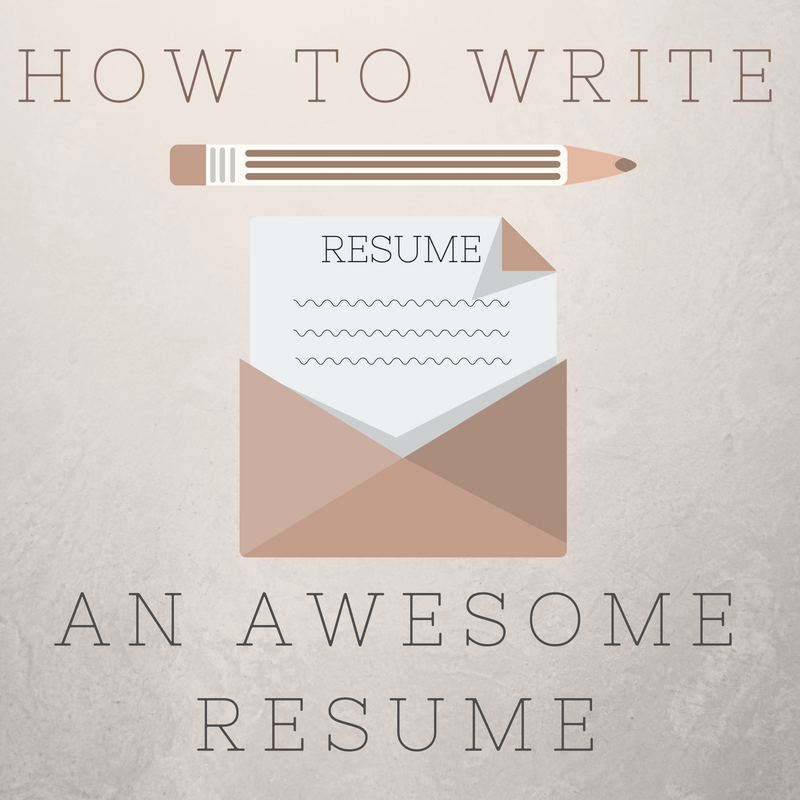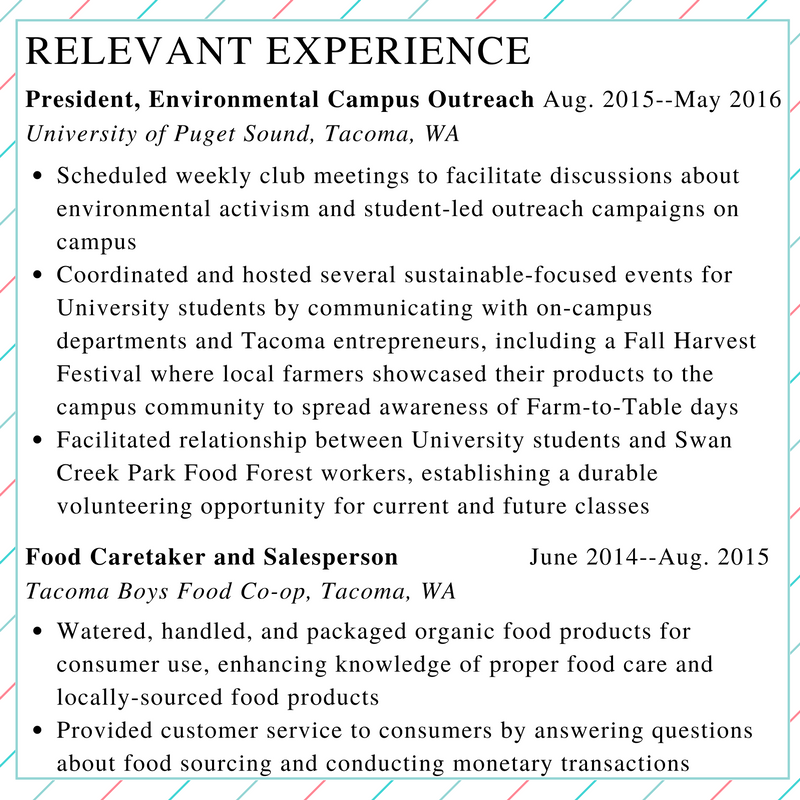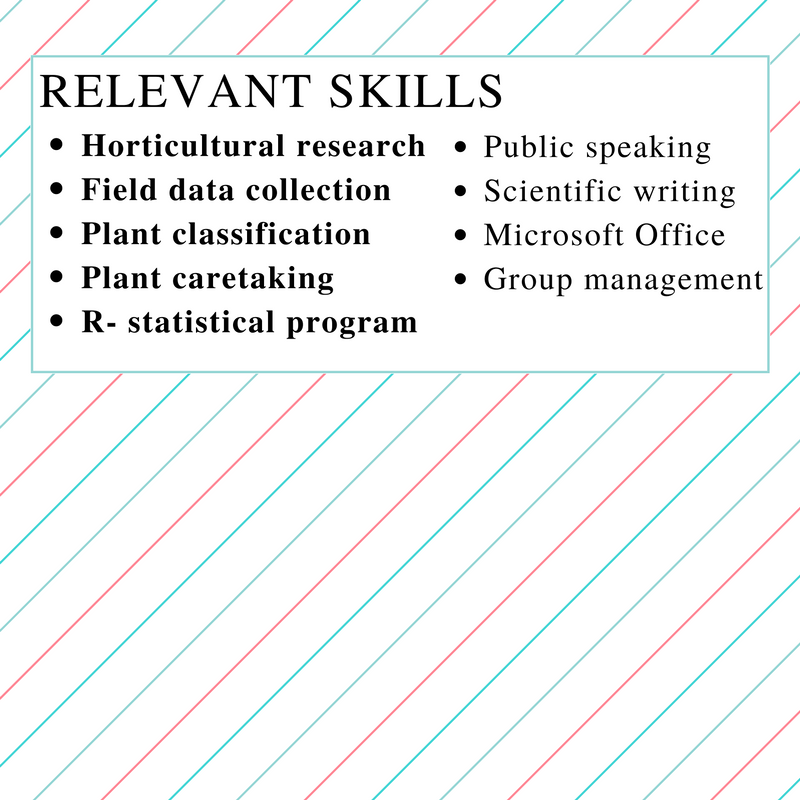Section 11.4 Writing Resumes
What is a Resume?
A resume is a list of your education history, past employment, professional skills/knowledge, and any other qualifications that are relevant to the job to which you are applying. Even if you are applying for many jobs within a similar field, you will likely need to revise your resume for every job application you submit (for instance, if you are applying for a computer tech position, you probably wouldn’t include your cat-sitting experience). However, there are some basic things you need to include in every resume to make it as strong as possible.

Contact.
The contact serves as both the heading of your resume and offers the various ways your prospective employer can contact you. A contact can be personalized based on how you would best like to present yourself, but it generally includes your:
- Full name, large and centered
- Permanent mailing address
- Email address
- Cell phone number
- URL for your LinkedIn profile or other personal website (if you have one)
- Fax number or any other relevant way of contacting you
![This graphic shows a professional heading for a resume, which includes the following text, centered: “"Abigail Apple [large, all-caps font, followed by a line break] 1111 Orchard Lane, Tacoma, WA 98416 [line break] Email: aapple@pugetsound.edu [line break] Cell: (253) 555-5555 [line break] LinkedIn profile: www.linkedin.com/in/aapple"](external/contactinfo.png)
Education.
In the education section, include your degree, graduation month and year, where you went to college/university, your GPA, awards won (month and year), and relevant cocurricular activities (include date range, or month and year). Remember to list only those awards and activities that may be relevant to the job application.
![This graphic shows the education section of an example resume. At the top is the heading "Education" in a larger, all-caps font. Below the heading is the following text: "Bachelor of Science (B.S.)--Horticulture [several spaces] May 2016 [line break] University of Puget Sound (Tacoma WA) [line break] Magna Cum Laude, GPA: 3.80 [line break] Awards Won: Dean’s List (Fall 2013-Spring 2016); Outstanding Senior in Horticultural and Earth Sciences (Spring 2016); Summer Science Scholar (Summer 2015) [line break] Relevant Co-Curricular Activities: Horticultural Sciences Honor Society (March 2015--); Gardening Club (Jan. 2013-May 2016); Environmental Campus Outreach Club (Aug. 2013-May 2016)"](external/education.png)
Past Relevant Experience.
In the past experience section, try to select a few relevant experiences or positions in reverse chronological order (most recent at top) that lend themselves particularly well to the job to which you are applying. For each experience, include:
- the position or role you held (bolded)
- the institution or agency at which you held it (italicized)
- the city, state in which the institution/agency is located (italicized)
- the date range for which you held it (right-aligned)
- a brief, past-tense summation of your specific responsibilities and duties you had in that role (in fragment sentences, bulleted)
Keep in mind that these experiences do not necessarily need be paid employment, but should rather reflect your qualifications and accomplishments working in a relevant or related field. Use fragment bullet points to list the duties you performed in each position and try to be as specific as possible when describing these duties, limiting yourself to two to four bullet points per position. For instance, rather than “honed social skills” as a campus visit host, you could describe how you “greeted, engaged with, and answered questions for prospective students and their families during one-hour informational tours.” Try to highlight only the most important duties of a particular position and to avoid repeating similar tasks and skills; for instance, if you “conducted scheduling and administrative and office support” for multiple positions, you may want to include this only for the positions in which this was a critical part of the job. Remember that your resume should have an overarching focus but that different positions may emphasize different aspects of your qualifications.

If you have independent research that you would like to showcase, for each research project, include the:
- name of your project (bolded and in quotes)
- date range you conducted said research (right-aligned)
- venue (conference, symposium, etc.) at which it was presented (italicized)
- city and state in which it was conducted/presented (italicized)
- brief synopsis of your research, final format of research (poster, paper, thesis, publication), and any awards conferred upon it (bulleted)
Remember to include only research that appropriately showcases your qualifications for the job to which you are applying. Like your past experiences section, keep the bullet-point descriptions of your research simple and to a minimum.
Relevant Skills.
Many resumes have a relevant skills section that allows potential employers (or a computerized application tracking system) to easily scan your abilities and qualifications. It offers a list of terms for skills that you have accumulated and gained proficiency in during your work/research experiences and that you will likely utilize in the position to which you are applying. It can include more umbrella terms like “public speaking” or “presentation experience” as well as more specific names for particular programs or techniques, such as “R- statistical programs” or “Microsoft Excel.” You can include as many skills as you like, but limit yourself to only those skills that are relevant to the specific job. Bold those skills that are more pertinent than others, and use two-column formatting to save space.

-
Tailor your resume to the job.Just as you did while writing your cover letter, you will want to tailor your resume to the job to which you are applying. However, unlike your cover letter, you should not explicitly mention the job to which you are applying or how these experiences have prepared you for that specific position (that’s what the cover letter is for).
-
Use simple prose.Your resume is not the place to show off your writing abilities to your potential employer—save that for the cover letter. Rather, resumes should use clear and concise prose (often bulleted fragments) to showcase 1) what you’ve done and 2) how it contributed to your overall preparedness.
-
Avoid using vague or overused phrases.Try to be as specific as possible when describing your past work experience and skills. If you are adept at using a particular software program, technical skill, research method, lab procedure, writing type, or other form of specialized knowledge, name it explicitly.
-
Format your resume cleanly and with selective emphasis.While bold and italics can in some instances highlight those skills you most want to showcase, be selective with the emphases you use. Typically, it is best to place emphasis on (in whichever way, based on your preferences): your name, your degree, school, and GPA (if applicable), titles of positions held, titles of specific research projects, and any specific skills you want to draw attention to in the “Skills” section. Dates of work experiences can also be right-aligned to preserve a sense of aesthetic balance to your resume. Above all, try to figure out a professional-looking format that works best for you and your experiences and keep it consistent throughout.
For more tips and tricks on how to write a great cover letter, see this Cover Letter Guide. Remember that you can always bring your resume to your career services office for more editing ideas! Remember that you can always bring your resume drafts to career services office (the career services office location) for editing and revising ideas!
1
www.pugetsound.edu/files/resources/ces-cover-letter-guide.pdf